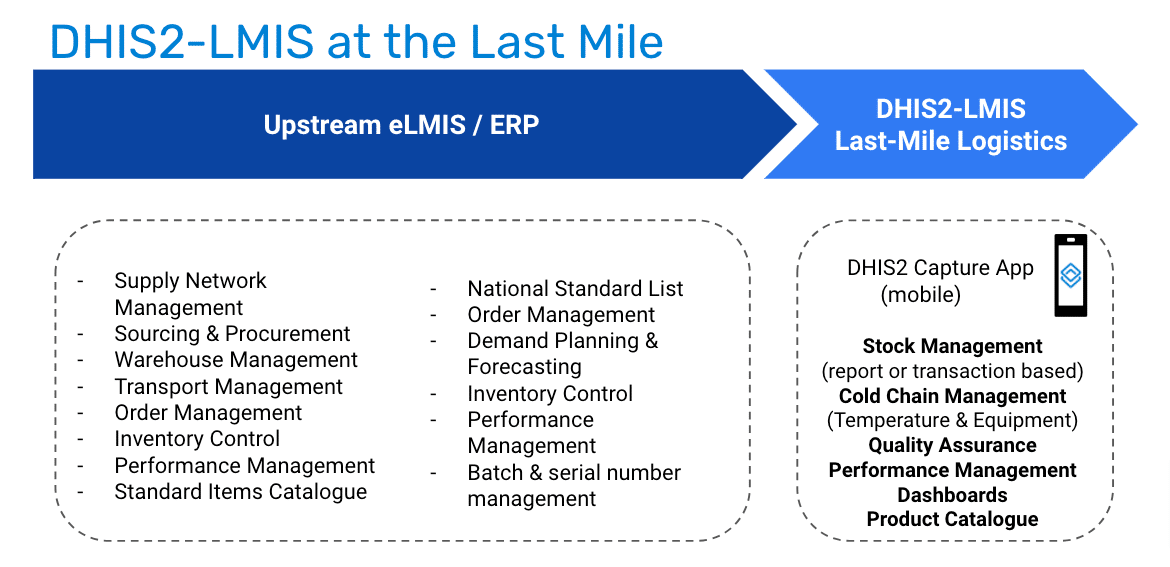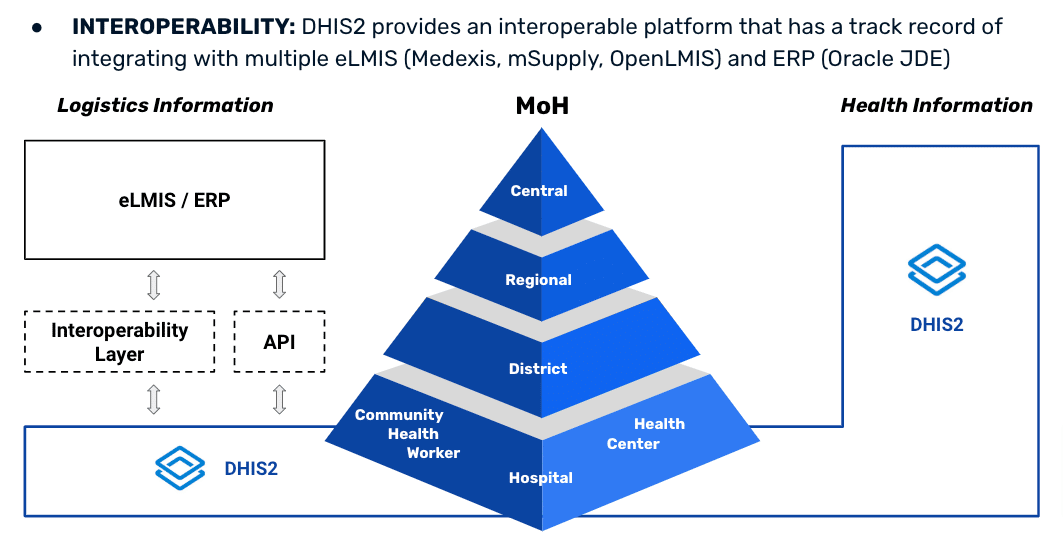mSupply
This webinar from November 2023 presents a detailed overview of the DHIS2 LMIS integration approach, mSupply eLMIS system, and the workflow integration between the two systems.
Considerations for and benefits of integrating DHIS2 with a central system to provide end-to-end supply chain management
While DHIS2 can be used as a facility-level eLMIS tool, a more comprehensive DHIS2-LMIS approach relies on integration with a central eLMIS or ERP to achieve end-to-end supply chain management capability. This approach (1) takes into account the need for a dedicated supply chain management tool that is able to manage stock transactions across organization unit levels, forecast needs and manage orders over time, and many other specialized features, and (2) leverages the benefits of DHIS2 and its ability to be implemented in the lowest levels of the health structure, in a cost-effective manner, to connect the last-mile of the supply chain with the central level tool.
This page presents some functional/business requirements and methods for DHIS2-LMIS integration. For technical integration topics, please visit the DHIS2 Integration page.
The following diagram shows a breakdown of features covered by DHIS2-LMIS at the facility level (see the core DHIS2-LMIS use cases page to learn more) and those that are recommended to be covered by the central eLMIS or ERP. We have prepared a detailed comparison of DHIS2 and ERP features based on guidelines from the Interagency Supply Chain Group to support countries in planning an integrated approach.

Below is a simple representation of the data flow and levels of implementation for DHIS2-LMIS at facility level and the central eLMIS or ERP, connected by an interoperability layer or direct API connection. This diagram also shows how DHIS2 is implemented for health information at all levels of the health system as a national HMIS. As DHIS2 is commonly already in use for facility-level health data collection, this allows for the collection of facility-level logistics and supply chain data without the introduction of an additional end-user software system, and facilitates the triangulation of logistics, service delivery, and health outcome data for holistic analysis and program management.

Resources can be shared and aligned between DHIS2 and the other systems being integrated. For example, DHIS2 implementations will commonly have the most up to date facility structure in the country, due to its regular use and maintenance. This can be aligned with the eLMIS/ERP.
The Master Product List (MPL): The MPL should naturally be managed by a central tool, however, the product specifications can be configured in DHIS2 to use the eLMIS/ERP as the source of truth. In DHIS2, products are managed at a generic level, but this functionality will be expanded to include batch and expiry management in the future.
Workflows: Different logistics workflows can also be aligned between systems, for example, order confirmation between shipping facilities using eLMIS/ERP and receiving facilities using DHIS2. Another example is shipment received confirmation, once deliveries are made to facilities. Additional workflows can also be modeled and customized according to country needs. Finally, data capture at the facility level can be used for demand planning and forecasting in the eLMIS/ERP, to provide accurate consumption data for decision making.
Here you can learn about real-world examples of DHIS2 integration with eLMIS platforms.
This webinar from November 2023 presents a detailed overview of the DHIS2 LMIS integration approach, mSupply eLMIS system, and the workflow integration between the two systems.
This presentation by i+solutions at the 2022 DHIS2 Annual Conference describes the integration of Medexis and DHIS2 for supply chain management in Mali as part of a USAID-funded health project. An update on this project was presented in French at the 2023 DHIS2 Annual Conference.
This session from the 2023 DHIS Annual Conference includes a presentation by the ICRC (International Committee of the Red Cross) on its Pharmacy Stock Management (PSM) tool that integrates DHIS2 and Oracle.